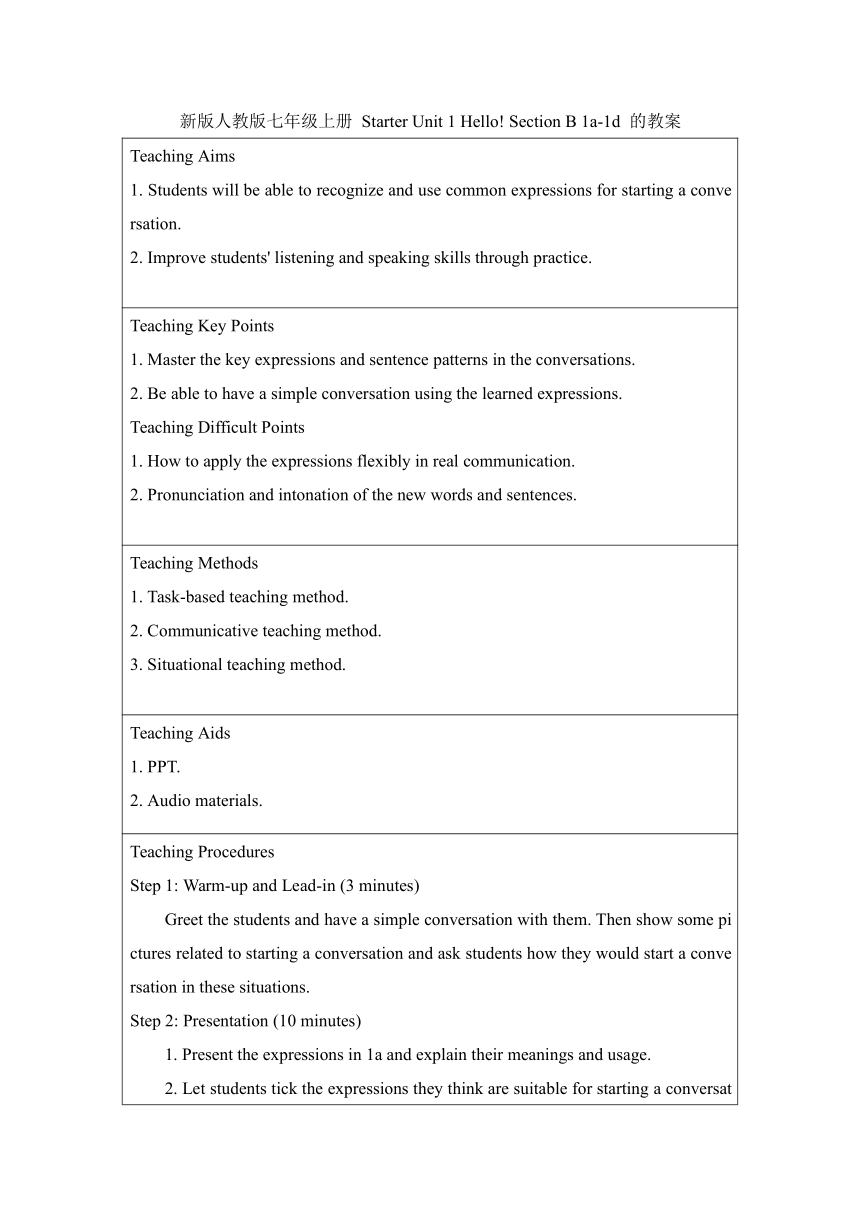 资源简介
资源简介
新版人教版七年级上册 Starter Unit 1 Hello! Section B 1a-1d 的教案
Teaching Aims1. Students will be able to recognize and use common expressions for starting a conversation.2. Improve students' listening and speaking skills through practice.
Teaching Key Points1. Master the key expressions and sentence patterns in the conversations.2. Be able to have a simple conversation using the learned expressions.Teaching Difficult Points1. How to apply the expressions flexibly in real communication.2. Pronunciation and intonation of the new words and sentences.
Teaching Methods1. Task-based teaching method.2. Communicative teaching method.3. Situational teaching method.
Teaching Aids1. PPT.2. Audio materials.
Teaching ProceduresStep 1: Warm-up and Lead-in (3 minutes)Greet the students and have a simple conversation with them. Then show some pictures related to starting a conversation and ask students how they would start a conversation in these situations.Step 2: Presentation (10 minutes)1. Present the expressions in 1a and explain their meanings and usage.2. Let students tick the expressions they think are suitable for starting a conversation.Step 3: Reading Practice (7 minutes)1. Ask students to read the two conversations in 1b silently.2. Check their understanding by asking some questions about the conversations.Step 4: Fill in the Blanks (10 minutes)1. Students complete the blanks in 1c independently.2. Check the answers together and explain the grammar points if necessary.Step 5: Conversation Practice (15 minutes)1. Guide students to complete the conversations in 1d.2. Have students practice the conversations in pairs.3. Invite some pairs to perform in front of the class.Step 6: Summary and Homework (5 minutes)1. Summarize the key points of this lesson.2. Assign homework: Ask students to write a short conversation using the expressions learned.Hope this teaching plan is helpful to you!
教学反思:一、成功之处1. 教学目标明确明确了学生需要掌握的重点表达式和对话,如“How are you ” “I'm fine, thanks.” 等,教学目标达成情况较好。2. 多种教学活动结合通过 1a 的勾选练习、1b 的阅读对话、1c 的填空以及 1d 的补全对话等多种活动,让学生在不同形式的练习中巩固所学知识,提高了语言运用能力。3. 注重互动与交流在教学过程中,鼓励学生积极参与,进行小组讨论和同桌对话练习,增加了学生的语言输出机会,培养了他们的口语表达和合作能力。二、不足之处1. 部分学生参与度不够尽管设计了多种活动,但仍有少数学生积极性不高,参与度较低。在今后的教学中,需要更加关注这部分学生,采取个性化的教学方法,激发他们的学习兴趣。2. 时间把控不够精准在 1b 的阅读对话环节花费时间较多,导致后面 1c 和 1d 的练习时间略显紧张,部分学生没有充分完成练习。以后需要更合理地安排各环节的时间。3. 对学生的错误纠正不够及时在学生进行口语表达时,出现了一些语法和发音错误,没有及时给予纠正和指导,可能会影响学生的语言准确性。三、改进措施1. 关注个体差异提前了解学生的学习情况和特点,针对不同水平的学生设计不同难度的任务,让每个学生都能在课堂上有所收获。2. 优化时间管理提前预演教学过程,更准确地预估各环节所需时间,并在课堂上根据学生的实际情况灵活调整。3. 加强错误纠正更加关注学生的语言输出,及时发现并纠正错误,同时鼓励学生互相纠错,提高他们的自我修正能力。总之,通过对这堂课的教学反思,我认识到了教学中的优点和不足,在今后的教学中会不断改进,提高教学质量。
展开更多......
收起↑
 资源预览
资源预览

 资源预览
资源预览
